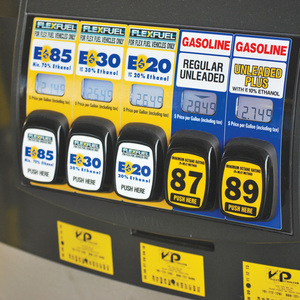Vander Griend calls for test standards for ethanol blends

April 9, 2014
BY Susanne Retka Schill
The ethanol industry needs to call for new fuel testing standards when testing gasoline with varying ethanol content, according to Steve Vander Griend, technical manager of fuel and engine technology at ICM Inc. He pointed to yet another study that shows varying vehicle emission results that were influenced by how test fuels were formulated. The paper, SAE Paper 2014-01-1451, is being presented by a team from the University of California at the SAE 2014 World Congress & Exhibition, Thursday, April 10. Looking at E10, E15 and E20 results, the authors find that ethanol makes a small reduction to particulate emissions, but raises toxic benzene and other emissions.
In his letter to the authors, Vander Griend requested the paper be peer reviewed a second time “to evaluate the changes made in the gasoline base for each of the ethanol blended fuels. The reason for this request is due to the fact that ICM has conducted and collected research proving the exact opposite of some of this paper’s conclusions.”
Advertisement
The conclusions of this paper are a result of the way the test fuels are prepared, Vander Griend explained. The California studies being questioned, he said, are using what is called match blending. “While the base fuel being E10 (10 percent ethanol) is being evaluated in comparison to E15 and E20 (15 and 20 percent ethanol respectively), the gasoline blend at 85 percent (E15) and 80 percent (E20) also varies,” he wrote in his letter to the authors.
“There is no reason to focus on just ethanol in this paper when there are multiple changes done to the base fuel,” Vander Griend told Ethanol Producer Magazine. “The ethanol industry needs to start talking about standards in how ethanol is tested.
“ICM would like the ethanol industry to know that a standard is not out there as to how ethanol should be tested,” he continued. “If there is one thing I have learned from the Coordinated Research Council history of studies, fuel blending is done very differently depending on the scope of the vehicle testing. I can easily make ethanol look very good or very bad for performance and emission in regards to the parameters I use when ordering the fuel, and still keep the fuel in specification per ASTM regulations.”
Advertisement
“We need SAE and other organizations to recognize how test fuels need to be blended and create some sort of standard practice,” Vander Griend said. He pointed to a second paper being presented at the SAE World Congress by a Polish group that references the U.S. EPA’s EPAct study that finds ethanol increasing particulate matter emissions. “We can demonstrate that the results of this study do not match real world emissions,” he said. For an earlier article explaining Vander Griend’s critique of the EPAct study and other ethanol tests click here.
Related Stories
The U.S. Energy Information Administration maintained its forecast for 2025 and 2026 biodiesel, renewable diesel and sustainable aviation fuel (SAF) production in its latest Short-Term Energy Outlook, released July 8.
XCF Global Inc. on July 10 shared its strategic plan to invest close to $1 billion in developing a network of SAF production facilities, expanding its U.S. footprint, and advancing its international growth strategy.
U.S. fuel ethanol capacity fell slightly in April, while biodiesel and renewable diesel capacity held steady, according to data released by the U.S. EIA on June 30. Feedstock consumption was down when compared to the previous month.
XCF Global Inc. on July 8 provided a production update on its flagship New Rise Reno facility, underscoring that the plant has successfully produced SAF, renewable diesel, and renewable naphtha during its initial ramp-up.
The U.S. EPA on July 8 hosted virtual public hearing to gather input on the agency’s recently released proposed rule to set 2026 and 2027 RFS RVOs. Members of the biofuel industry were among those to offer testimony during the event.
Upcoming Events










